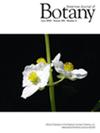The landscape genetics of a mass-flowering fire-ephemeral plant
Abstract
Premise
Obligate fire ephemerals are annual plants that have germination and reproduction cued by fire occurrence, persisting between fire events in a long-lived soil seed bank. Within these species, gene flow is restricted not only geographically but also temporally because individuals are limited to reproducing with others affected by the same fire event. The patchwork-like distribution of fires may therefore promote population isolation. In contrast to past fires, the Australian fires of 2019–2020 were of unprecedented extent, providing an opportunity to investigate the landscape genetics of a fire ephemeral, Actinotus forsythii, across multiple populations and to compare it to a common congener, Actinotus helianthi.
Methods
For both species, we used single nucleotide polymorphisms to infer patterns of population structure and calculate measures of genetic diversity. We also estimated a phylogeny of Actinotus forsythii to understand the differentiation of a geographically isolated population.
Results
For A. forsythii, the within-population diversity (allelic richness = 1.56) was greater, and the among-population differentiation (FST = 0.30) was lower than that observed for A. helianthi (allelic richness = 1.33, FST = 0.57). Actinotus forsythii had distinct geographic groupings, and a geographically isolated population of this species was genetically highly differentiated.
Conclusions
Despite the fire-dependent, asynchronous gene flow, predicted between site disconnect, and possible within-site homogeneity, our results suggest that burn mosaic could be influencing gene flow patterns and fire-triggered mass flowering may promote genetic diversity within Actinotus forsythii.

 求助内容:
求助内容: 应助结果提醒方式:
应助结果提醒方式:


